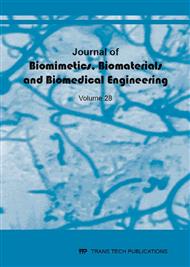[1]
S. M. Kurtz, E. Lau, J. Schmier, K.L. Ong, K. Zhao, J. Parvizi, Infection burden for hip and knee arthroplasty in the United States, Journal of Arthroplasty, 23 (2008) 984-991.
DOI: 10.1016/j.arth.2007.10.017
Google Scholar
[2]
T.N. Peel, K.L. Buising, P. F. M. Choong, 2011. Prosthetic joint infection: Challenges of diagnosis and treatment, Anz Journal of Surgery 81 (2011) 32-39.
DOI: 10.1111/j.1445-2197.2010.05541.x
Google Scholar
[3]
M. Stigter, J. Bezemer, K. de Groot, P. Layrolle, Incorporation of different antibiotics into carbonated hydroxyapatite coatings on titanium implants, release and antibiotic efficacy, Journal of Controlled Release 99 (2004) 127-137.
DOI: 10.1016/j.jconrel.2004.06.011
Google Scholar
[4]
L.G. Harris, S. Tosatti, M. Wieland, M. Textor, R.G. Richards, Staphylococcus aureus adhesion to titanium oxide surfaces coated with non-functionalized and peptide-functionalized poly(L-lysine)-grafted- poly(ethylene glycol) copolymers, Biomaterials 25 (2004).
DOI: 10.1016/j.biomaterials.2003.11.033
Google Scholar
[5]
M. Gimeno, P. Pinczowski, M. Perez, A. Giorello, M.A. Martinez, J. Santamaria, M. Arruebo, L. Lujan, A controlled antibiotic release system to prevent orthopedic-implant associated infections: An in vitro study, European Journal of Pharmaceutics and Biopharmaceutics 96 (2015).
DOI: 10.1016/j.ejpb.2015.08.007
Google Scholar
[6]
F. Zhang, Z. Zhang, X. Zhu, E.T. Kang, K.G. Neoh, Silk-functionalized titanium surfaces for enhancing osteoblast functions and reducing bacterial adhesion, Biomaterials, 29 (2008) 4751-4759.
DOI: 10.1016/j.biomaterials.2008.08.043
Google Scholar
[7]
C.F. Huang, H. J. Chiang, W. C. Lan, H. H. Chou, K.L. Ou, C.H. YU, Development of silver-containing austenite antibacterial stainless steels for biomedical applications Part I: Microstructure characteristics, mechanical properties and antibacterial mechanisms, Biofouling 27 (2011).
DOI: 10.1080/08927014.2011.582642
Google Scholar
[8]
Y. F. Zheng, B.B. Zhang, B.L. Wang, Y. B. Wang, L. Li, Q. B. Yang, L. S. Cui, Introduction of antibacterial function into biomedical TiNi shape memory alloy by the addition of element Ag, Acta Biomaterialia 7 (2011) 2758-2767.
DOI: 10.1016/j.actbio.2011.02.010
Google Scholar
[9]
L. Zhang, J.W. Yan, Z.W. Yin, C. Tang, Y. Guo, D. Li, B. Wei, Y. Xu, Q.R. Gu, L.M. Wang, Electrospun vancomycin-loaded coating on titanium implants for the prevention of implant-associated infections, International Journal of Nanomedicine 9 (2014).
DOI: 10.2147/ijn.s63991
Google Scholar
[10]
J.A. Jennings, D.P. Carpenter, K.S. Troxel, K.E. Beenken, M.S. Smeltzer, H.S. Courtney, W.O. Haggard, Novel Antibiotic-loaded Point-of-care Implant Coating Inhibits Biofilm, Clinical Orthopaedics Related Research 473 (2015) 2270-2282.
DOI: 10.1007/s11999-014-4130-8
Google Scholar
[11]
L. Zhao, P.K. Chu, Y. Zhang, Z. Wu, Antibacterial coatings on titanium implants, Journal of Biomedical Materials Research - Part B Applied Biomaterials 91 (2009) 470-480.
DOI: 10.1002/jbm.b.31463
Google Scholar
[12]
A. Ewald, S.K. Glückermann, R. Thull, U. Gbureck, Antimicrobial titanium/silver PVD coatings on titanium, BioMedical Engineering Online 5 (2006).
DOI: 10.1186/1475-925x-5-22
Google Scholar
[13]
M. Bosetti, A. Massè, E. Tobin, M. Cannas, Silver coated materials for external fixation devices: In vitro biocompatibility and genotoxicity, Biomaterials 23 (2002) 887-892.
DOI: 10.1016/s0142-9612(01)00198-3
Google Scholar
[14]
C. Marambio-Jones, E.M.V. Hoek, A review of the antibacterial effects of silver nanomaterials and potential implications for human health and the environment, Journal of Nanoparticle Research 12 (2010) 1531-1551.
DOI: 10.1007/s11051-010-9900-y
Google Scholar
[15]
Y. Z. Wan, S.F. Raman, He, Y. Huang, Surface modification of medical metals by ion implantation of silver and copper, Vacuum 81 (2007), 1114-1118.
DOI: 10.1016/j.vacuum.2006.12.011
Google Scholar
[16]
M. Wen, Y. Li, J. Zhang, W. Guan, Y. Li, C. Wen, P. Hodgson, Synthesis and characterization of nanostructured Ag on porous titania, Applied Surface Science 257 (2011) 4836-4843.
DOI: 10.1016/j.apsusc.2010.12.102
Google Scholar
[17]
E.P. Ivanova, J. Hasan, V.K. Truong, J.Y. Wang, M. Raveggi, C. Fluke, R.J. Crawford, The influence of nanoscopically thin silver films on bacterial viability and attachment, Applied Microbiology and Biotechnology (2011) 1-9.
DOI: 10.1007/s00253-011-3195-5
Google Scholar
[18]
M. Marini, S. de Niederhausern, R. Iseppi, M. Bondi, C. Sabia, M. Toselli, F. Pilati, Antibacterial activity of plastics coated with silver-doped organic-inorganic hybrid coatings prepared by sol-gel processes, Biomacromolecules 8 (2007).
DOI: 10.1021/bm060721b
Google Scholar
[19]
P.J. Kelly, H. Li, K.A. Whitehead, J. Verran, R.D. Arnell, I. Iordanova, A study of the antimicrobial and tribological properties of TiN/Ag nanocomposite coatings, Surface and Coatings Technology 204 (2009) 1137-1140.
DOI: 10.1016/j.surfcoat.2009.05.012
Google Scholar
[20]
W. Chen, S. Oh, A.P. Ong, N. Oh, Y. Liu, H.S. Courtney, M. Appleford, J.L. Ong, Antibacterial and osteogenic properties of silver-containing hydroxyapatite coatings produced using a sol gel process, Journal of Biomedical Materials Research - Part A 82 (2007).
DOI: 10.1002/jbm.a.31197
Google Scholar
[21]
P. Pereira, Chitosan nanoparticles for biomedical applications, Nova Science Publisher, New York, (2010).
Google Scholar
[22]
T. Wu, X. Hua, Z. He, X. Wang, X. Yu, W. Ren, The bactericidal and biocompatible characteristics of reinforced calcium phosphate cements, Biomedical Materials 7 (2012).
DOI: 10.1088/1748-6041/7/4/045003
Google Scholar
[23]
J.D. Bumgardner, R. Wiser, P.D. Gerard, P. Bergin, B. Chestnutt, M. Marini, V. Ramsey, S.H. Elder, J.A. Gilbert, Chitosan: Potential use as a bioactive coating for orthopaedic and craniofacial/dental implants, Journal of Biomaterials Science, Polymer Edition 14, (2003).
DOI: 10.1163/156856203766652048
Google Scholar
[24]
H.J. Martin, K.H. Schulz, J.D. Bumgardner, K.B. Walters, XPS study on the use of 3-aminopropyltriethoxysilane to bond chitosan to a titanium surface, Langmuir, 23 (2007) 6645-6651.
DOI: 10.1021/la063284v
Google Scholar
[25]
H.J. Martin, K.H. Schulz, J.D. Bumgardner, K.B. Walters, An XPS study on the attachment of triethoxsilylbutyraldehyde to two titanium surfaces as a way to bond chitosan, Applied Surface Science 254 (2008) 4599-4605.
DOI: 10.1016/j.apsusc.2008.01.066
Google Scholar
[26]
P.H. Chua, K.G. Neoh, E.T. Kang, W. Wang, Surface functionalization of titanium with hyaluronic acid/chitosan polyelectrolyte multilayers and RGD for promoting osteoblast functions and inhibiting bacterial adhesion, Biomaterials 29 (2008).
DOI: 10.1016/j.biomaterials.2007.12.019
Google Scholar


